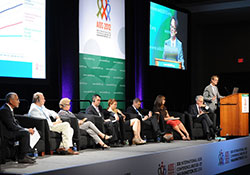AIDS 2012: growing HIV epidemic in eastern Europe and central Asia a concern

IAS/Ryan Rayburn
Representatives from across the world gathered at a special session of the XIX International AIDS Conference (AIDS 2012) in Washington, DC, United States of America this week, to highlight the key issues in and solutions to the growing challenge of HIV in eastern Europe and central Asia.
Although HIV is stabilizing and declining globally, the epidemic in eastern European and central Asian countries continues to grow at an alarming and accelerating pace. Martin Donoghoe, WHO/Europe’s Programme Manager for HIV/AIDS, Sexually Transmitted Infections and Viral Hepatitis, presented at the conference the stark facts about the HIV epidemic in these countries on behalf of a regional working group. The latest figures show that 1.5 million people in eastern Europe and central Asia are living with HIV: 3.5 times the number for 2001 (410 000) and more than 10 times that for 1991.
Donoghoe pointed out that only 23% of those in need receive antiretroviral therapy: “Africans with HIV are more likely to get antiretroviral drugs than eastern Europeans and central Asians. Treatment is not keeping pace with infection, and AIDS and AIDS-related deaths continue to rise.”
Greater risks for socially marginalized people
HIV disproportionately affects groups that are socially marginalized and people whose behaviour is socially stigmatized or criminalized: injecting drug users and their sexual partners, men who have sex with men, sex workers, prisoners and migrants. They often lack access to services to prevent, diagnose and treat HIV. Where such services exist, they are limited and poorly integrated with other health services.
Tuberculosis and end-stage liver disease caused by viral hepatitis C infection are among the leading causes of death among people living with HIV/AIDS, particularly those who are also dependent on drugs.
Although global spending on HIV is increasing, problems in eastern Europe and central Asia include both overreliance on international funds and underinvestment in programmes for key populations at higher risk.
Strong political commitment essential
Considering these facts, a panel of politicians, specialists in HIV prevention and treatment, and activists from across the Region debated the issues and proposed some solutions.
Michel Kazatchkine, who the United Nations Secretary-General recently appointed his Special Envoy for HIV/AIDS in Eastern Europe and Central Asia, chaired the panel. “Let us keep a sense of urgency. So many lives are at stake,” he said. “We cannot accept seeing the epidemic continue to grow in the Region, when it is decreasing elsewhere in the world, and having 23% of patients in need of therapy accessing it when these figures exceed 50% worldwide. It’s time to remobilize against the epidemic in the Region, and reverse these trends.”
Sandra Elizabeth Roelofs, the First Lady of Georgia and WHO/Europe’s Goodwill Ambassador for the health-related Millennium Development Goals, and Hanno Pevkur, Estonia’s Minister of Social Affairs, used examples from their countries to demonstrate how, with strong political commitment, solutions to the HIV epidemic can be found.
HIV activists from the Russian Federation and Ukraine described how, despite the challenges in the Region, pan-European networks and organizations are fighting the vulnerability and marginalization of key populations at higher risk of HIV. Further, treatment and prevention specialists from the Russian Federation and Kyrgyzstan commented on the declining rates of mother-to-child transmission in their countries.



